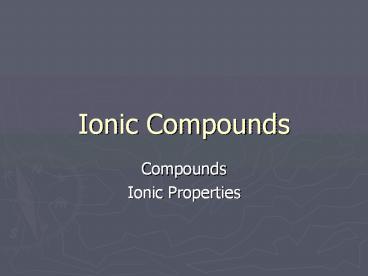Ionic Compounds PowerPoint PPT Presentation
Title: Ionic Compounds
1
Ionic Compounds
- Compounds
- Ionic Properties
2
Ionic Compounds
- The ratio of cations to anions is always such
that an ionic compound has no overall charge
3
Ionic compounds Vs Molecules
- Ionic Compounds Do Not Consist of Molecules
- Water is a molecular compound, so individual
water molecules are each made of two hydrogen
atoms and one oxygen atom. - Sodium chloride is an ionic compound, so it is
made up of many Na and Cl? ions all bonded
together to form a crystal. There are no NaCl
molecules
4
Ionic Compounds
- Metals and nonmetals tend to form ionic compounds
and not molecular compounds
5
Ionic Bond Strength
- Attractive forces exist between oppositely
charged ions and involve more than a single
cation and anion - Six Na ions surround each Cl? ion and vice
versa. - As a result, the attractive force between
oppositely charged ions is significantly greater
in a crystal than it would be if the ions existed
only in pairs. - Overall, the attractive forces are much stronger
than the repulsive ones, so ionic bonds are
strong
6
Ionic Properties
- Most ionic compounds have high melting and
boiling points because of the strong attraction
between ions - Like NaCl, most ionic compounds are hard and
brittle. - Hard means that the crystal is able to resist a
large force applied to it. - Brittle means that when the applied force becomes
too strong to resist, the crystal develops a
widespread fracture rather than a small dent.
7
Ionic Conductivity
- Ionic solids, such as salts, generally are not
conductors because the ions cannot move. - When a salt melts or dissolves, the ions can move
about and are excellent electrical conductors.
8
(No Transcript)
9
How to Identify a Compound as Ionic
- All ionic compounds are solid at room
temperature. - Tap the substance.
- Ionic compounds do not break apart easily and
they fracture into tiny crystals. - Heat the substance.
- Ionic compounds generally have high melting and
boiling points. - Use a conductivity device to find if the
dissolved or melted substance conducts
electricity. - Dissolved and molten ionic compounds conduct
electricity.
10
Assignment
- Finish
- SG 33-34
- Ion Worksheet
- Add Ions to periodic Table
- Text pg 175
- 1-11
PowerShow.com is a leading presentation sharing website. It has millions of presentations already uploaded and available with 1,000s more being uploaded by its users every day. Whatever your area of interest, here you’ll be able to find and view presentations you’ll love and possibly download. And, best of all, it is completely free and easy to use.
You might even have a presentation you’d like to share with others. If so, just upload it to PowerShow.com. We’ll convert it to an HTML5 slideshow that includes all the media types you’ve already added: audio, video, music, pictures, animations and transition effects. Then you can share it with your target audience as well as PowerShow.com’s millions of monthly visitors. And, again, it’s all free.
About the Developers
PowerShow.com is brought to you by CrystalGraphics, the award-winning developer and market-leading publisher of rich-media enhancement products for presentations. Our product offerings include millions of PowerPoint templates, diagrams, animated 3D characters and more.

